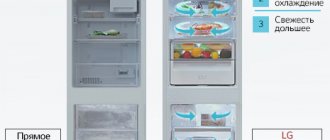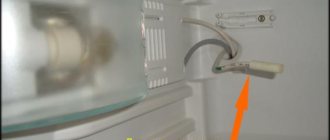The small area of kitchen rooms or the absence of basements often force owners to place refrigeration equipment on balconies. No less common are cases where a refrigerator is left running in the countryside in winter. Without going into technical details, none of these actions are justified: open the owner's manual and look at the operating temperature range of the unit. Usually the minimum mark is +5° C, and this number is not taken out of thin air. Also, the operation of electrical equipment is strictly prohibited on an unglazed balcony due to high humidity. For the same reason, sockets cannot be installed on the balcony.
As you can see, an attempt to force the refrigerator to work in the wrong place violates 3 rules at once (violation of operating conditions, for example, will void the warranty). And if you go into details, even more so.
“All winter at the dacha, in an unheated house, an old single-compressor Sharp worked. Alive and well."
Sergey
Is it possible to turn it on at sub-zero temperatures?
The instructions for using the refrigerator indicate that the minimum temperature at which the unit is allowed to operate is +5 degrees. Ideal conditions are from +10 degrees. Failure to comply with this harms the elements of the device, causing them to malfunction: corrosion, damage, oxidation.
The main element of the refrigerator that suffers the most is its engine. In the cold, the oil needed to lubricate the parts thickens, there is not enough pressure to move the freon, the seal bursts - all this requires investment for repair. If the refrigerator is new, the warranty will not work in this case, because the conditions for storing and using the unit were not met.
How to store a tool in winter so as not to repair it in the spring: useful tips
Users of the portal tell how to make sure that in the spring, power tools, welding inverters and lawn mowers work and start without problems
With the onset of cold weather, many home-made workers and country residents end the season and curtail all work until spring. Garden tools, chainsaws, gas trimmers, welding inverters, drills, screwdrivers and grinders are sent to garages, outbuildings and sheds for conservation. At the same time, people are concerned with questions: how to store tools in winter, whether they will deteriorate due to low temperatures, and how to use them if brought from the cold to a warm room. Let's find out the opinion of FORUMHOUSE participants!
- How to preserve a gasoline spit for winter storage
- Is it possible to store a welding inverter in an unheated room?
- Where to store electric tools in winter and how to use them correctly in the cold
Preparing a gasoline scythe for winter storage and preservation
A tool such as a lawn mower can be called a well-deserved “hard worker.” If the grass on the site is rushing, or a neglected area needs to be cleared of weeds, then do not let go of the gasoline scythe. In winter, the lawn mower is sent to a well-deserved rest - in the barn or in the shed, until the next season. We offer you a set of simple recommendations, following which, you can easily start a lawn mower next year, and the tool itself will safely overwinter in an unheated room.
- Remove the line from the trimmer head or unscrew the cutting blade. Clean the instrument from grass, sand and dirt.
- Unscrew the cap and drain the remaining gasoline from the tank into a container of suitable volume.
- Start the trimmer and let it run until it exhausts the remaining fuel mixture that is in the fuel line and carburetor.
- After the lawn mower stalls, remove the spark plug and unscrew the spark plug.
- Take a disposable syringe and inject 5 ml of the oil you use to prepare the gasoline mixture for a two-stroke engine into the combustion chamber.
- Rotate the piston by gently pulling the starter cord handle several times. This will distribute the oil evenly throughout the cylinder.
- Wrap the spark plug and put on the spark plug.
It is not recommended to store a gasoline scythe with the spark plug unscrewed, as dirt or small objects can get into the combustion chamber through the hole in the cylinder head.
- Check the air and fuel filters. If they are dirty, wash and dry the air filter thoroughly and replace the fuel filter.
- Store the lawn mower in a hanging position, for example, on the wall of a shed or shed.
The most typical malfunctions when operating a refrigerator in cold weather
When operating a refrigeration unit in a cold room, the following malfunctions may occur:
- Difficulty refrigerating food. This problem is directly related to the operation of the thermostat. The essence of the device is that when the compressor cools the refrigerator to the desired temperature, a sensor is triggered, transmitting the command to the refrigerator motor to turn off. So the unit sits for some time and begins to heat up again due to incomplete thermal insulation. Then the compressor starts working again and cools the interior again. This is normal operation of the refrigerator. But if it stands on the balcony in winter, no heat will enter it from the surrounding space, which means that the compressor does not need to turn on to cool the unit. This option is suitable for a refrigerator compartment, but what if you need to freeze food, and the freezer gives the same temperature as in the environment? Of course, such work is unlikely to lead to breakdowns, but it will cause great inconvenience in use.
- But this problem can cause serious problems with the refrigerator motor. Usually old generation refrigerators, produced in the Soviet Union, are placed on balconies. They use R12 and R22 refrigerants, which are compatible with mineral and semi-synthetic oils. They are extremely unstable to low temperatures, and if the air warms up by less than +5 degrees, they begin to thicken. All oil-lubricated parts of the compressor are subject to additional stress and it is harder for them to rotate. To make them work in the desired mode, a large current supply is required, which cannot be provided. As a result, the protective relay is activated. Modern refrigerator models use refrigerants starting from R134 and later, which work together with synthetic oils. Such refrigerators are more resistant to cold.
- If the compressor can still start in the cold, then there may be a problem with the movement of freon, which is needed to cool the refrigerator. Old refrigerators most often cope with this task, but only for 3-5 minutes. Modern models have many sensors that determine the operating conditions of the unit. They will not allow the device to run idle for 3-5 minutes, the protective relay will work.
- The occurrence of “wet running”. Freon is initially in a liquid state, and enters the compressor in gaseous form. In order to process freon, the evaporator must absorb sufficient heat. If there is not enough of it, the freon vapor will contain drops of liquid, which can lead to complete destruction of the refrigerator compressor elements.
- If the unit is a model with a “No Frost” or drip defrosting system, then the cold ambient temperature will cause problems in the functioning of these systems. These refrigerators imply automatic defrosting of the chamber, but for normal operation it is necessary to comply with the temperature conditions specified in the instructions.
- Each refrigerator has a rubber seal that is located on the doors of the refrigerator and freezer compartments. It is needed in order to ensure insulation of the internal space of the refrigerator from the external environment, due to which the cold remains in the unit longer. But the refrigerator seal does not withstand frost, as a result it cracks or even breaks off.
- Cold outside is usually accompanied by high humidity. The refrigerator contains many metal elements and electrical circuits that can oxidize and rust. If moisture gets on some elements, a short circuit is even possible, which, at best, will lead to breakdown of the refrigerator itself, and at worst, it can even cause a fire.
Is it possible to use the freezer in the cold?
Some freezers can be used for outdoor storage in winter. This depends on the design features of the refrigerator. For example, most models are a unit with one compressor with independent temperature conditions in the freezer and the main chamber. If the thermometer drops below 4 degrees, both compartments will stop performing their functions.
In single-compressor models with one regulator for the main compartment and freezer, the situation is similar to the previous one. If the external temperature is below 40C, the food in the freezer will not freeze, since the compressor will not start. In cases of Full No Frost, the condition in the freezing chamber is regulated by a special temperature sensor. At a value above -24 degrees, its cooling mode is activated. Therefore, the freezer will function even in winter, but due to rare cycles, the compressor will be heavily loaded, and the oil will freeze during idle time.
Some freezers can turn on even at low outside temperatures. The range inside the chamber is from -24 to -18 degrees, and as long as the thermometer outside is above this value, the operation will be stable.
What to do if you need to use the refrigerator in an unheated room
The best thing you can do for your unit is to place it in a warm place. If it is not possible to move it to another room, a glazed loggia or a summer cottage insulated veranda will do. In severe frost, the temperature of these rooms will still drop below +5 degrees, so you should worry about heating in advance.
You can help the refrigerator heat the compressor for safe startup, then it will heat itself. To do this, they use fan heaters, heat guns, even “warm rugs” for animals and heating pads - any available means. The main thing is to remember safety precautions.
Particular attention should be paid to the insulation of internal engine elements. If moisture gets, for example, on a bare wire, it can lead not only to damage, but even to a fire, so it’s worth taking care of safety in advance.
Do not forget that by performing these actions, you are putting yourself and your refrigerator at risk. It is best to use it under the conditions specified in the instructions.
Manufacturers' recommendations
Manufacturers of most refrigerator models recommend placing and using appliances in rooms with temperatures from +16 to +32°C. Some models are suitable for operation in a wider range from +10 to +43°C.
Important! If the refrigerator breaks down due to violation of operating conditions, the manufacturer’s warranty does not apply.
Failure to comply with the manufacturer's recommendations reduces the service life of the unit and leads to breakdowns.
Climate class
Let us dwell in more detail on climate classes and their characteristics.
There are four main classes:
- N (normal) – temperature range from +16 to +32°С;
- SN (subnormal) – temperature range from +10 to +32°C, the device can be used in poorly heated rooms (loggias, basements, etc.);
- ST (subtropical) – temperature range from +18 to +38°С, operation in hot climates with high humidity;
- T – (tropical) – temperature range from +18 to +43°С, operation in dry tropical climates.
Most of the models presented on the Russian market belong to normal (N) and subnormal (SN) climate classes. There are also multi-class models that combine two or three classes (for example, N-ST, SN-ST, SN-T). Refrigerators belonging to dual classes are distinguished by higher energy consumption and higher prices.
Information about which climate class the refrigerator belongs to is indicated in the technical documentation for the device and on the sticker on the unit body.
Storing a refrigerator at subzero temperatures
It is worth remembering that when storing a refrigerator in the cold, the integrity of many of its components is compromised: seals may crack, electrical circuits may oxidize, etc. But if there are no options for placing the unit in a warm place, then to slow down the destructive processes as much as possible, you should use these tips:
- Before placing the refrigerator for storage, it must be unplugged, defrosted, washed and packed.
- Packing the unit involves covering it tightly with cloth and then with film. This is necessary to prevent condensation from forming on the engine elements. During storage, it is forbidden to open the refrigerator doors - the rubber seals may crack.
- The refrigerator must be thoroughly dried before switching on, otherwise condensation may cause a short circuit.











